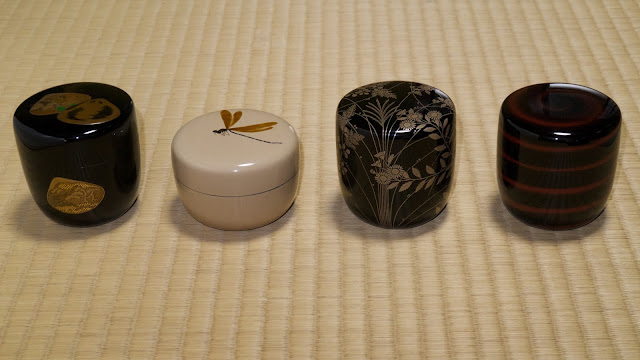 |
An abstract rendering of a dove formed in a mould and elegantly decorated with chips of mother-of-pearl.
|
Father and Son
Just as in many other parts of the world a great many of Japan’s traditional crafts have been handed down from Father to Son. In the case of the Wakashimas, however, Mr. Wakashima Senior learnt the greater part of his skills as an apprentice. His son, Hidetaka, on the other hand, took some formal training to top up what he absorbed sitting beside his father watching and learning. These days this is a common story amongst those engaged in traditional crafts. In recent times training establishments have been set up in many production centres leading to an increase of those who have adopted a craft rather than having been born into it.
 |
More of a charger than a tray it is used to tastefully display food.
|
When I visited the Wakashimas, the three of us sat in a bare, dimly lit tatami-matted room with a small cup of green tea at hand and discussed lacquerware in general as well as how it is made in Wajima.
I am lucky. I have acquired enough proficiency in Japanese to be able to converse, if not like a native speaker, at least well enough so that people feel relaxed when talking to me. Few hesitate to see if I have understood and many, even diehard craftsmen, seem to be more willing to open up to me, a foreigner, than they would be to talk to another Japanese. This may be because they welcome the interest I show in their work.
 |
A stationary box decorated with mother-of-pearl flowers.
|
Of course it was Mr. Wakashima Senior who was holding the floor. And so the conversation progressed with occasional prompts from Hidetaka when I looked puzzled by a word either in dialect or one so peculiar to the craft that even an uninformed Japanese would not understand.
 |
On the left is a finished natsume, in the middle one reinforced with cloth—the hallmark of Wajima lacquerware—and turned and uncoated one on the right.
|
Father has often made the kind of tea caddies used in the tea ceremony—or as my on-screen dictionary defines it, “an elaborate Japanese ritual of serving and drinking of tea, as an expression of Zen Buddhist philosophy”. Simply put that is it in a nutshell but in truth Tea is as deep as it is broad and as complex as any piece of human behaviour could be.
The tea caddy is a small lidded container to hold the powdered green tea used in the ceremony. Hidetaka’s Father told me that he became interested in the weight of these caddies, called natsume in Japanese. He once went to a museum, which holds some caddies actually used by the sixteenth-century Tea Master Sen no Rikyu, to ask if he might borrow one to weigh. Sadly they refused.
 |
The delicacy of the autumnal design is so appealing.
|
Anyway natsume do vary slightly in size and the wood from which they are made so there is perhaps no definitive answer. The small one I have that was turned and lacquered by a very respected craftsman only weighs 25g, about a sixth of the weight of an iPhone. Incidentally, the ideal weight of the pottery tea bowl used in the ceremony is said to be 300g. This is considered to be the perfect weight for the handleless bowl, which is held in both hands to drink the frothy green tea.
Ideal weights are not the only thing that are given considerable and careful consideration in the tea ceremony. The choice of items to be used at a ceremony will vary according to the season of the year, the time of day and make-up of the whole ensemble of accoutrements as well as who the guests might be.
 |
Just image how good an ensemble of delicious treats could look in this gleaming, mould-made piece of lacquerware.
|
It was not long before we began to talk of seeing and photographing actual pieces of Father’s work. A number of the pieces were one-off studio craft pieces of lacquerware made using a mould and a loosely woven hemp or linen cloth. The cloth is charged with lacquer and then laid in the mould. After the lacquer has hardened, more lacquer-charged cloth is added and again allowed to harden. Once removed from the mould more and more coats of lacquer can be added, then rubbed down, burnished and polished until it gleams or is left with a refined matt finish. Using this method forms that cannot be turned from wood can be achieved with great effect.
The continued popularity of the tea ceremony means that the Wakashimas have customers for their work, both Father and Son. Although in Hidetaka’s case it is the continued popularity of saké that he must partly thank for his livelihood. More of that another day as well as much more one day about the tea ceremony.
Bill Tingey Photo © Copyright
Do feel free to pass on the address of this blog to anyone you think will be interested. Or post it on a social media site. Should you wish to leave a comment, please do so by clicking on the comment mark at the bottom left of this or any of the other posts. If you have found this blog interesting, why not become a follower.


No comments:
Post a Comment